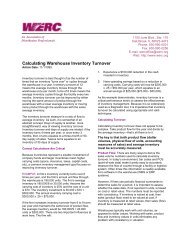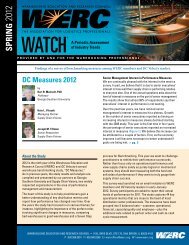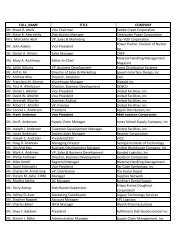Optimizing Inventory Management - WERC
Optimizing Inventory Management - WERC
Optimizing Inventory Management - WERC
Create successful ePaper yourself
Turn your PDF publications into a flip-book with our unique Google optimized e-Paper software.
processes<br />
<strong>Optimizing</strong> <strong>Inventory</strong> <strong>Management</strong> continued from page 1<br />
2<br />
“IO implementations often reach into the warehouse/DC<br />
environment, especially when postponement strategies<br />
are used to retain product flexibility and pool demand<br />
from multiple DCs or customers.”<br />
Expectations<br />
Organizations tend to blame inaccurate forecasting<br />
for their service level problems. In fact, Bursa maintains,<br />
“the demand signal can be used by IO tools to vastly<br />
improve both anticipation of and response to changing<br />
customer/market demand.” In addition, she notes that<br />
IO can:<br />
Identify all the stages of inventory. Point out exactly<br />
which stock is excess inventory and where it is stored<br />
in the supply chain<br />
Show the value of postponing differentiation steps<br />
and pooling demand from multiple customers or<br />
downstream DCs<br />
Confidently reduce finished goods inventory and<br />
reduce obsolescence<br />
Position finished goods inventory for better service<br />
levels in response to changing markets<br />
Understand which warehouse space can be freed<br />
up (and which shouldn’t be)<br />
Refine Kanbans and Min-Max levels for maximum<br />
effectiveness<br />
Extend inventory management to customer DCs for<br />
better demand signal sensing and more control.<br />
There is a distinction between warehouse management<br />
systems and inventory optimization.<br />
<strong>WERC</strong>Sheet® (USPS # 014998) is published bi-monthly by the<br />
Warehousing Education and Research Council, 1100 Jorie Blvd.,<br />
Ste. 170, Oak Brook, IL 60523-3016.<br />
Phone: (630) 990-0001 Fax: (630) 990-0256<br />
E-mail: wercoffice@werc.org Website: www.werc.org<br />
Annual membership dues are $275, including $80.00 for an<br />
annual subscription to <strong>WERC</strong>Sheet. Periodicals postage rates<br />
paid at Oak Brook, IL (Vol. 33, No. 5)<br />
POSTMASTER: Send address changes to <strong>WERC</strong>Sheet,<br />
1100 Jorie Blvd., Ste. 170, Oak Brook, IL 60523-3016.<br />
<strong>WERC</strong> assumes no responsibility for unsolicited manuscripts<br />
or other materials submitted for review.<br />
Editor: Rita Coleman<br />
Copyright © 2010 by the Warehousing Education and Research<br />
Council. All rights reserved.<br />
Reproduction in whole or part without written permission is<br />
prohibited. Internet inquiries: www.werc.org.<br />
Writers: Amanda Loudin and Joseph Mazel<br />
/ September–October 2010<br />
“Warehouse management systems are, at the heart,<br />
inventory management systems, but they are largely<br />
limited to the warehouse and are more about inventory<br />
flow than optimization,” explains Ellis. “<strong>Inventory</strong> optimization<br />
tools, on the other hand, look at multiple kinds of<br />
inventory at multiple points in the supply chain—of<br />
which the warehouse is just one point.” A full-breath,<br />
multi-echelon inventory optimization tool can help<br />
answer questions like:<br />
How much inventory should I hold of each product,<br />
and where is the most cost-efficient point to store<br />
that inventory?<br />
My products are often seasonal or cyclical in terms of<br />
demand — how do I most efficiently plan and deploy<br />
overall inventory?<br />
What business policies are driving inventory investment<br />
across the entire supply chain?<br />
If I must improve service, how much incremental<br />
inventory investment will I need? Conversely, if I<br />
decrease service level, how much inventory can I<br />
free up?<br />
How will a change in a supplier or production location<br />
impact my overall inventory cost or customer service<br />
levels?<br />
Can I increase margins and improve service by<br />
holding inventory in a different location?<br />
How can I best deploy a combination push-pull<br />
supply chain or an inventory risk-pooling model?<br />
“An inventory optimization tool essentially sets the<br />
‘rules’ for inventory levels across the supply chain, allowing<br />
the warehouse management system to then execute<br />
order picking and loading based on available stock,”<br />
according to Ellis.<br />
Early warning signs<br />
Increasing rates of finished goods obsolescence,<br />
stock-outs, expediting or channel stuffing are all<br />
indicators of problems stemming from either excess<br />
inventory or poor demand signal sensing. Also, poor<br />
inventory turns compared to industry averages or your<br />
main competitors’ is a sure sign that IO is needed, according<br />
to Bursa.<br />
“Warehouse managers who see these issues must<br />
strongly consider IO as a means to reverse these trends<br />
and improve their supply chain processes,” she advises.<br />
“It is really quite simple: if your business is operating<br />
with high inventory levels, or inventory reduction initiatives<br />
are getting in the way of service delivery then<br />
an inventory optimization tool may be very helpful,”<br />
maintains Ellis.







